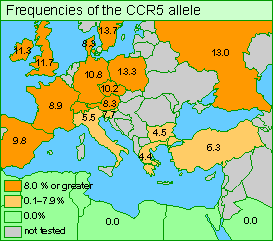127 000-year old mutation protects from AIDS
Around 1% of the Europeans, or 70 000 Bulgarians are protected against HIV
When you hear about mutation, probably you think of something "bad". In this case that bad turns to be a natural protection against one of the most devastating syndromes of our time - AIDS.
The mutation is found amongst 4-15% of the European population It's most common in Northern Europe, while the percentage decreases in the south, and it's the rarest on the Balkans. This "protecting" mutation has never been found in Africans. Therefore, it shouldn't be surprising that the infection with HIV is most common on the Black continent. The East Asians and Indians are also not naturally protected against AIDS.
THE DANGEROUS INFORMATION
Not long ago American researchers spread the statistic about the vulnerability of different nations towards the disease. According to them, the protecting mutation is present in 4.5% of the Bulgarian population. Probably this number has been reached through indirect data, because no such studies have been conducted in our country and
there is no statistic. "Whether or not, a person carries this mutation can be confirmed through DNA analysis. If once and for all, the needed methodology is established, then the specific individual can be examined for presence of the virus. In order to establish the distribution of the mutation amongst the population, a screening of it would be suitable. The question is if that's needed. It might turn out that the distribution of the information, acquired through such a wide research, can be socially dangerous", says Doc. Dr. Georgi Miloshev – leader of the Lab of Molecular Genetics of the Institute of Molecular Biology of BAN (Bulgarian Academy of Sciences).
How could this information be dangerous?
Those, who were made aware of being insusceptical to AIDS might calm down and indulge in promiscuous sex or lean towards intravenous drug addiction. (These are the two ways, in which infection is the easiest). But in this way, the distribution of other diseases, transmitted through sex or intravenous way, such as syphilis and Hepatitis C, will increase tremendously. The number of heroin addicts will increase as well, because the gene mutation can protect them against AIDS, but is in no way helpful against addictions.
THE SAVIOR - CCR5-DELTA-32
In 2010 the registered carriers of HIV in Bulgaria were 1520, but according to Doc. Miloshev the number is probably closer to 1600-1700 people. He explains how exactly the specific gene mutation protects against AIDS: "The HIV virus, which causes the disease, attacks cells of the immune system. In order to penetrate in them, it should connect with two receptors – conditionally speaking, entries of the cell, through which
different substances enter, including such, which serve her as food. One of these receptors is called CCR5. If the HIV virus doesn't connect with it, no infection can occur.
There are people with mutations in the gene for this receptor, which makes it non-standard. One of the most popular mutations is marked as CCR5-delta-32. Its carriers are less vulnerable to infection, because the mutation has changed the receptor,
and the virus cannot connect to it anymore. If someone inherits this mutation from both their parents, they are absolutely protected against AIDS. But such people represent only around 1% of the European population. Another 4-15% of the Europeans have inherited the mutation from one of the parents only- either the mother, or the father. They are more vulnerable to infection than the mentioned 1%, but are still more resistant
than those, who don't have the mutation at all. "

MUTATION BECAUSE OF THE PLAGUE
The researchers, who spread the data of the distribution of the CCR5- delta-32 mutation amongst the Europeans, suppose that it originated around 127 000 years ago in Northern Europe, where its distribution is the largest. Later on, with the migration of people, it moved to the south. They also determined that the frequency of this mutation has rapidly increased amongst the European population in the middle Ages. This must have happened because of an event, which had pressured the Europeans. Thereby, the
carriers of this mutation survive, and those who don't have it, don't. Scientists believe that such a selective event might have been an enormous plague epidemic. A reason for such an assumption would be the fact that except protection against AIDS, this mutation ensures resistance against the virus of plague. In other words, the people, who have it, get sick or die of Black Death with a lower frequency. By surviving, they vertically transmit it to the further generations.
CURE THROUGH GENE ENGINEERING?
Learn about the latest studies and scientific experiments with CCR5-delta-32 mutation in issue 1/2013 yr. of Magazine Ossem!
The mutation is found amongst 4-15% of the European population It's most common in Northern Europe, while the percentage decreases in the south, and it's the rarest on the Balkans. This "protecting" mutation has never been found in Africans. Therefore, it shouldn't be surprising that the infection with HIV is most common on the Black continent. The East Asians and Indians are also not naturally protected against AIDS.
THE DANGEROUS INFORMATION
Not long ago American researchers spread the statistic about the vulnerability of different nations towards the disease. According to them, the protecting mutation is present in 4.5% of the Bulgarian population. Probably this number has been reached through indirect data, because no such studies have been conducted in our country and
there is no statistic. "Whether or not, a person carries this mutation can be confirmed through DNA analysis. If once and for all, the needed methodology is established, then the specific individual can be examined for presence of the virus. In order to establish the distribution of the mutation amongst the population, a screening of it would be suitable. The question is if that's needed. It might turn out that the distribution of the information, acquired through such a wide research, can be socially dangerous", says Doc. Dr. Georgi Miloshev – leader of the Lab of Molecular Genetics of the Institute of Molecular Biology of BAN (Bulgarian Academy of Sciences).
How could this information be dangerous?
Those, who were made aware of being insusceptical to AIDS might calm down and indulge in promiscuous sex or lean towards intravenous drug addiction. (These are the two ways, in which infection is the easiest). But in this way, the distribution of other diseases, transmitted through sex or intravenous way, such as syphilis and Hepatitis C, will increase tremendously. The number of heroin addicts will increase as well, because the gene mutation can protect them against AIDS, but is in no way helpful against addictions.
THE SAVIOR - CCR5-DELTA-32
In 2010 the registered carriers of HIV in Bulgaria were 1520, but according to Doc. Miloshev the number is probably closer to 1600-1700 people. He explains how exactly the specific gene mutation protects against AIDS: "The HIV virus, which causes the disease, attacks cells of the immune system. In order to penetrate in them, it should connect with two receptors – conditionally speaking, entries of the cell, through which
different substances enter, including such, which serve her as food. One of these receptors is called CCR5. If the HIV virus doesn't connect with it, no infection can occur.
There are people with mutations in the gene for this receptor, which makes it non-standard. One of the most popular mutations is marked as CCR5-delta-32. Its carriers are less vulnerable to infection, because the mutation has changed the receptor,
and the virus cannot connect to it anymore. If someone inherits this mutation from both their parents, they are absolutely protected against AIDS. But such people represent only around 1% of the European population. Another 4-15% of the Europeans have inherited the mutation from one of the parents only- either the mother, or the father. They are more vulnerable to infection than the mentioned 1%, but are still more resistant
than those, who don't have the mutation at all. "

MUTATION BECAUSE OF THE PLAGUE
The researchers, who spread the data of the distribution of the CCR5- delta-32 mutation amongst the Europeans, suppose that it originated around 127 000 years ago in Northern Europe, where its distribution is the largest. Later on, with the migration of people, it moved to the south. They also determined that the frequency of this mutation has rapidly increased amongst the European population in the middle Ages. This must have happened because of an event, which had pressured the Europeans. Thereby, the
carriers of this mutation survive, and those who don't have it, don't. Scientists believe that such a selective event might have been an enormous plague epidemic. A reason for such an assumption would be the fact that except protection against AIDS, this mutation ensures resistance against the virus of plague. In other words, the people, who have it, get sick or die of Black Death with a lower frequency. By surviving, they vertically transmit it to the further generations.
CURE THROUGH GENE ENGINEERING?
Learn about the latest studies and scientific experiments with CCR5-delta-32 mutation in issue 1/2013 yr. of Magazine Ossem!



